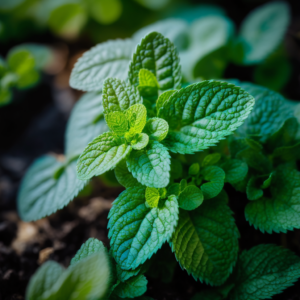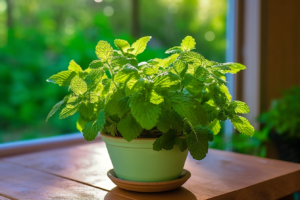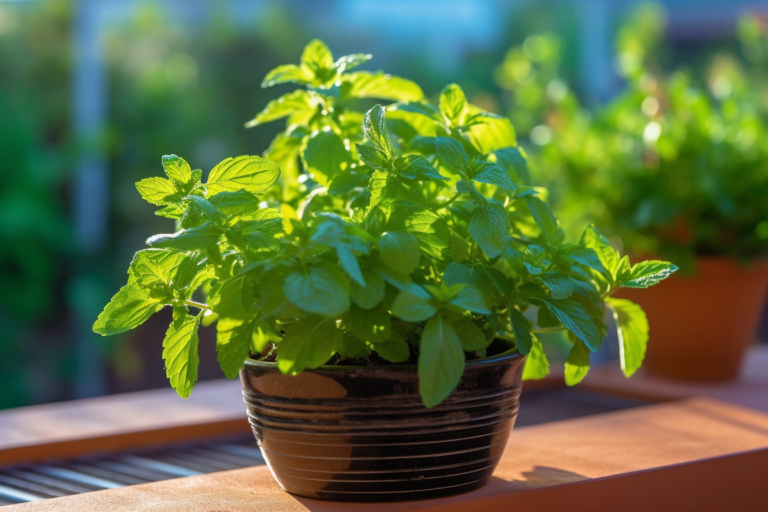Watering plants is a delicate balancing act, and mint is no exception. Mint is an aromatic, hardy herb that can thrive in a variety of conditions, but overwatering or underwatering can cause problems. In this article, we’ll explore how often to water mint, along with tips to ensure optimal growth.
Introduction: The Importance of Proper Watering
Mint plants are loved for their refreshing scent and delightful taste. However, proper watering is crucial to their health. Too little water can lead to wilted leaves, while too much can cause root rot. Let’s dive into the specifics of watering mint plants.
H2O and Mint: How Much Water Do They Need?
Mint’s Water Requirements
Mint plants prefer consistently moist soil, but not waterlogged. The ideal moisture level for mint is similar to a wrung-out sponge – damp but not dripping wet.

Signs of Overwatering and Underwatering
If your mint plant is receiving too much water, its leaves may turn yellow and drop off. On the other hand, underwatered mint plants often have dry, brown, and crispy leaves.
The Factors That Determine Watering Frequency
Several factors can impact how often you should water your mint plant, including:
- Climate: Mint plants require more frequent watering in hot and dry climates.
- Season: During the growing season, mint plants typically need more water.
- Pot Size: Smaller pots dry out faster, so mint plants in small containers may require more frequent watering.
- Soil Type: Well-draining soil reduces the risk of overwatering, but may require more frequent watering.
A Step-By-Step Guide to Watering Mint
Check the Soil Moisture
Before watering, stick your finger an inch into the soil. If it feels dry, it’s time to water your mint plant.
Water Thoroughly
Water your mint plant until water starts draining from the bottom of the container. This ensures that the roots receive adequate moisture.
Allow the Soil to Dry Slightly
Wait for the top inch of soil to dry out before watering again.
Adjust Your Watering Schedule
Monitor your mint plant’s health and adjust your watering schedule accordingly. If you notice signs of overwatering or underwatering, make necessary changes.
Tips for Growing Healthy Mint Plants
Here are some additional tips to help your mint plants thrive:
- Use well-draining soil: Mint plants prefer soil that drains well to prevent waterlogging.
- Mulch: Adding a layer of mulch can help retain moisture in the soil.
- Prune regularly: Regularly trimming your mint plant encourages bushier growth and prevents legginess.

Factors That Influence Mint’s Water Needs
There are a few key factors that can influence how often you should water your mint:
- Temperature: Mint plants prefer cooler temperatures and will require more water when it’s hot outside.
- Humidity: Mints thrive in humid environments, which means they may need more water if you live in a drier area.
- Container Size: The size of your container can influence how much water your plant needs. Smaller containers dry out faster and will need to be watered more frequently.
Signs Your Mint Plant Needs Water
One of the easiest ways to tell if your mint needs water is to check the soil. Stick your finger into the soil about an inch deep. If it feels dry, it’s time to water your plant.
Other signs your mint plant may need water include:
- Leaves wilting or drooping
- Yellowing leaves
- Stunted growth
How Often to Water Mint
In general, mint plants prefer moist soil but not waterlogged roots. Overwatering can cause root rot and kill your plant.
The frequency that you should water your mint will depend on the factors mentioned above. As a general rule of thumb, you should water your mint once the top inch or two of soil feels dry. This typically translates to once or twice a week, but be sure to monitor your plant and adjust your watering schedule as needed.
Table of Watering Frequency By Temperature
| Temperature (°F) | Watering Frequency (per week) |
|---|---|
| 60-70 | 1-2 |
| 70-80 | 2-3 |
| 80-90 | 3-4 |
By understanding your mint plant’s water needs, you can ensure that it stays healthy and produces delicious leaves for you to enjoy.
Thanks for the reminder, I will keep that in mind. Here’s the requested Markdown text about “Factors That Affect How Often You Need to Water Mint”:
Conclusion: Finding the Perfect Balance
In conclusion, the key to growing healthy mint plants is finding the perfect balance when it comes to watering. By understanding the factors that affect watering frequency and monitoring your mint plant’s health, you can ensure that your mint thrives and continues to provide its refreshing aroma and flavor.
Frequently Asked Questions
How often should I water my mint plant?
There's no one-size-fits-all answer to this question, as the watering frequency depends on factors such as climate, season, pot size, and soil type. However, a good rule of thumb is to water your mint plant when the top inch of soil feels dry.
Can I overwater my mint plant?
Yes, overwatering can lead to yellowing leaves and root rot. Make sure to water your mint plant only when the top inch of soil feels dry.
Is it better to water mint plants in the morning or evening?
It's generally better to water mint plants in the morning, as this allows the moisture to be absorbed by the roots before the heat of the day evaporates the water. Watering in the evening can also be acceptable, but avoid watering at night, as it can create a damp environment that encourages fungal growth.
Can mint plants recover from underwatering?
Yes, mint plants are relatively resilient and can often recover from underwatering. If your mint plant has dry, brown leaves, water it thoroughly and monitor its progress. With consistent care and proper watering, your mint plant may bounce back.
How can I tell if my mint plant is receiving the right amount of water?
A healthy mint plant will have vibrant green leaves and exhibit steady growth. If you notice signs of overwatering (yellowing leaves) or underwatering (dry, brown leaves), adjust your watering schedule accordingly. Remember to check the top inch of soil for dryness before watering.

